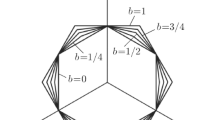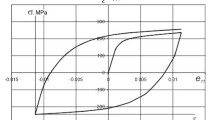Abstract
An approximate solution describing the compression of an axisymmetric layer ofmaterial on a rigid mandrel under the equations of the creep theory is constructed. The constitutive equation is introduced so that the equivalent stress tends to a finite value as the equivalent strain rate tends to infinity. Such a constitutive equation leads to a qualitatively different asymptotic behavior of the solution near the mandrel surface, on which the maximum friction law is satisfied, compared with the well-known solution for the creep model based on the power-law relationship between the equivalent stress and the equivalent strain rate. It is shown that the solution existence depends on the value of one of the parameters contained in the constitutive equations. If the solution exists, then the equivalent strain rate tends to infinity as the maximum friction surface is approached, and the qualitative asymptotic behavior of the solution depends on the value of the same parameter. There is a range of variation of this parameter for which the qualitative behavior of the equivalent strain rate near the maximum friction surface coincides with the behavior of the same variable in ideally rigid-plastic solutions.
Similar content being viewed by others
References
A. E. Johnson, “Complex-Stress Creep of Metals,” Metallurg. Rev. 5 (20), 447–506 (1960).
A. M. Lokoshchenko, Modeling of Creep Process and Long-Term Strength of Metals (MGIU, Moscow, 2007) [in Russian].
M. F. Sa, A. M. Gomes, J. R. Correia, and N. Silvestre, “Creep Behavior of Pultruded GFRP Elements–Part 1: Literature Review and Experimental Study,” Comp. Struct. 93 (10), 2450–2459 (2011).
G. W. Greenwood, “Reflections on Creep: A Review of the MST Archive,” Mater. Sci. Technol. 29 (8), 893–899 (2013).
J. P. Rouse, F. Cortellino, W. Sun, et al., “Small Punch Creep Testing: Review of Modelling and Data Interpertation,” Mater. Sci. Technol. 29 (11), 1328–1345 (2013).
M. Mondali and A. Abedian, “An Analytical Model for Stress Analysis of Short Fiber Composites in Power Law Creep Matrix,” Int. J. Nonlin.Mech. 57, 39–49 (2013).
N. N. Malinin, Creep inMetal Working (Mashinostroenie,Moscow, 1986) [in Russian].
S. E. Aleksandrov, V. L. Danilov, and N. N. Chikanova, “On the Stagnation Zone in a Simulation of Axisymmetric Pressure Metal Forming under Creep,” Izv. Akad. Nauk. Mekh. Tverd. Tela, No. 1, 149–151 (2000) [Mech. Solids (Engl. Transl.) 35 (1), 127–129 (2000)].
Y. Tomita and R. Sowerby, “An Approximate Analysis for Studying the Plane Strain Deformation of Strain Rate SensitiveMaterials,” Int. J. Mech. Sci. 21, 505–516 (1979).
N. Rebelo and S. Kobayashi, “A Coupled Analysis of Viscoplastic Deformation and Heat Transfer–II: Applications,” Int. J. Mech. Sci. 22, 707–718 (1980).
S. A. Shesterikov and M. A. Yumasheva, “Specification of Equation of State in Creep Theory,” Izv. Akad. Nauk SSSR.Mekh. Tverd. Tela, No. 1, 86–91 (1984) [Mech. Solids. (Engl. Transl.)].
A. M. Lokoshchenko, K. A. Agakhi, and L. V. Fomin, “Cantilever Creep in Bending in Aggressive Media,” Probl. Mashinostr. Nadezh. Mashin, No. 4, 70–75 (2013).
A. J. M. Spencer, “A Theory of the Failure of Ductile Materials Reinforced by Elastic Fibres,” Int. J. Mech. Sci. 7, 197–209 (1965).
S. E. Aleksandrov and Y.-R. Jeng, “A Generalization of Prandtl’s and Spencer’s Solutions on Axisymmetric Viscous Flow,” Arch. Appl.Mech. 81 (4), 437–449 (2011).
S. E. Aleksandrov and R. V. Goldstein, “Generalization of the Prandtl Solution to the Case of Axisymmetric Deformation of Materials Obeying the Double Shear Model,” Izv. Akad. Nauk. Mekh. Tverd. Tela, No. 6, 67–79 (2012) [Mech. Solids (Engl. Transl.) 47 (6), 654–664 (2012)].
R. Hill, TheMathematical Theory of Plasticity (Oxford Univ. Press, Oxford, 1950; Gostekhizdat,Moscow, 1956).
L.M. Kachanov, The Theory of Creep (Fizmatgiz, Moscow, 1960; Nat. Lending Lib., 1967).
S. E. Aleksandrov, “Velocity Field near the Surface of Discontinuity in an Arbitrary Flow of an Ideal Rigid- PlasticMaterial,” Izv. Akad. Nauk.Mekh. Tverd. Tela, No. 5, 116–122 (1995) [Mech. Solids (Engl. Transl.)].
S. E. Aleksandrov and O. Richmond, “Singular Plastic Flow Fields near Surfaces of Maximum Friction Stress,” Int. J. Nonlin.Mech. 36 (1), 1–11 (2001).
Author information
Authors and Affiliations
Corresponding author
Additional information
Original Russian Text © S.E. Aleksandrov, E.A. Lyamina, N.M. Tuan, 2016, published in Izvestiya Akademii Nauk, Mekhanika Tverdogo Tela, 2016, No. 2, pp. 64–75.
About this article
Cite this article
Aleksandrov, S.E., Lyamina, E.A. & Tuan, N.M. Compression of an axisymmetric layer on a rigid mandrel in creep. Mech. Solids 51, 188–196 (2016). https://doi.org/10.3103/S0025654416020060
Received:
Published:
Issue Date:
DOI: https://doi.org/10.3103/S0025654416020060




